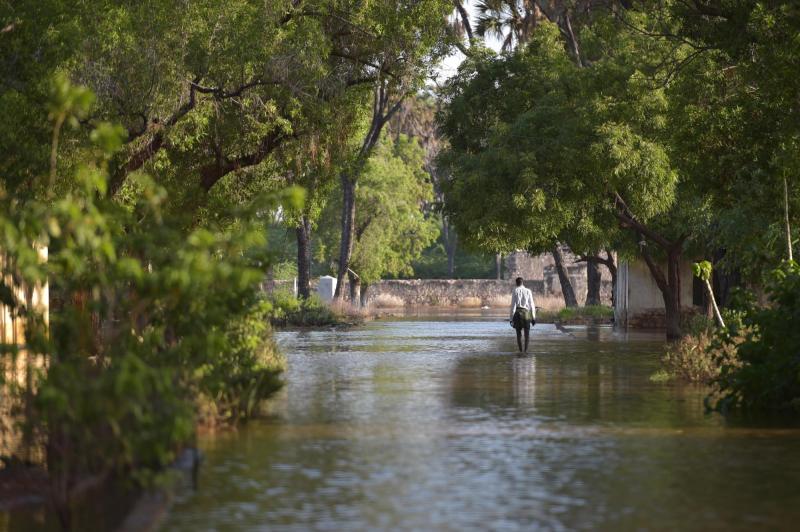What anticipatory action can learn from existing disaster risk management in the Horn of Africa
Anticipatory action in the Horn of Africa could draw lessons from previous disaster risk management strategies to circumvent their past mistakes and leverage their insights.
Anticipatory actions – interventions which are designed to mitigate shocks and crises before they escalate into emergencies – have garnered more attention in recent years as an important complement to wider disaster risk reduction. Yet challenges remain in scaling up anticipatory action, and much disaster management remains reactive. Currently, 90% of humanitarian funding globally is still dedicated to response rather than prevention; in Kenya, only 3% of total disaster risk finance is allocated to anticipated disasters.
This raises critical questions about how anticipatory action can be scaled up to mitigate disasters in fragile regions like the Horn of Africa, which has a long history of humanitarian crises. Since the early 1980s, the region has faced prolonged droughts, including the Ethiopian and Somali famines. Severe droughts in 2017 and 2022 led to significant livestock losses and food insecurity, with nearly 11 million livestock lost in Kenya, Ethiopia, and Somalia in 2022 alone. These disasters in the Horn of Africa and their compounded impacts – including heightened geopolitical and ethnic-based skirmishes, human and livestock immobility, and entrenched poverty – underscore the need to rethink how we plan for and respond to disasters in the region.
Revisiting the history of disaster risk management
The Horn of Africa nations are already signatories to a number of international disaster risk management frameworks, including the Sendai Framework for Disaster Risk Reduction, the Agenda for Humanity, Africa Regional Strategy for Disaster Risk Reduction, and the IGAD Drought Disaster Resilience and Sustainability Initiatives (IDDIRSI). The goal of these frameworks is to reduce vulnerability and enhance community resilience, reaffirming the aims of the Paris Agreement on climate change and other global commitments.
Under these frameworks, countries have shown some progress at managing disaster risks, with the establishment of early warning institutions, the emergence of drought management institutions, and governments’ adoption of national social protection schemes – cash transfers – to cushion communities against extreme food insecurity. In particular, Kenya’s National Drought Management Authority and Ethiopia’s National Disaster Risk Management Commission are examples of robust institutions coordinating drought responses and humanitarian interventions. But progress is limited, and each government faces challenges, including how to continue financing these efforts and how to navigate the differing priorities of changing administrations.
This is a challenge for scaling anticipatory action, as the leadership of governmental entities is critical to incorporating anticipatory actions within national departments, sectors and policies. As per the Sendai Framework, national governments are responsible for reducing disasters by ensuring proactive and integrated disaster management efforts – yet introducing a new drought management framework such as anticipatory action would require a new budget and significant political willpower.
Building on disaster risk management frameworks
In this testing environment, anticipatory action programme designers would do well to adopt some lessons from previous disaster risk management frameworks in the Horn of Africa.
Firstly, anticipatory action needs to be better linked with government-led social protection programmes. Incorporating anticipatory action into long-term government disaster risk management strategies can establish systems that promptly address immediate risks while simultaneously fostering resilience – and which do not require a completely separate instrument or institution.
This is not happening currently. While numerous pilot projects on anticipatory action, concerning drought and flood triggers and potential responses, exist in the Horn of Africa, they are largely driven by humanitarians, lacking sufficient participation from development donors, banks, and national policymakers. This fragmented dialogue may hinder the integration of anticipatory action into broader disaster risk management and developmental programming.
If governments mainstream anticipatory action within social protection programmes, ensuring guaranteed and scalable financing, but also committing to incorporate anticipatory action finance in development planning, they will expand the options available to people in advance of disasters, including financing health, education, nutrition and elderly support.
Secondly, technical working groups on anticipatory action – which are made up of humanitarian, red cross, NGOs, government agencies, and research centres – could take some lesson from previous disaster risk management strategies, including the Hyogo Framework for Action, Agenda for Humanity and New Ways of Working, which emphasise collaboration and coordination of disaster risk management. Sharing knowledge is critical to augment anticipatory action initiatives. Whilst the region seeks to standardise triggers, partners should be open to sharing and adapting lessons from their counterparts, and exchanging best practices for effective anticipatory action. Lessons need to be learnt about what forms of coordination work, including from pandemic lessons such as COVID-19 responses and how to improve overall coordination on anticipatory action.
Finally, anticipatory aid programming in the Horn of Africa needs to be more localised. Unlike the top-down approach to anticipatory action, “anticipatory action from below” establishes a more robust foundation for learning. As SPARC research has shown, locally led anticipatory actions are far from linear; instead, they adopt a broader, multi-hazard range of interventions that reflect the reality of the challenges people face. Strategies that are adaptable and deeply rooted in these local realities contribute to sustained resilience against the dynamic threats posed by climate change. Reciprocity, shared values, norms, and social networks are essential for locally led anticipatory actions. Donors and governments should incentivise humanitarian and development actors to define solutions focused on local perspectives, incorporating past, present and future knowledge on disaster management.
